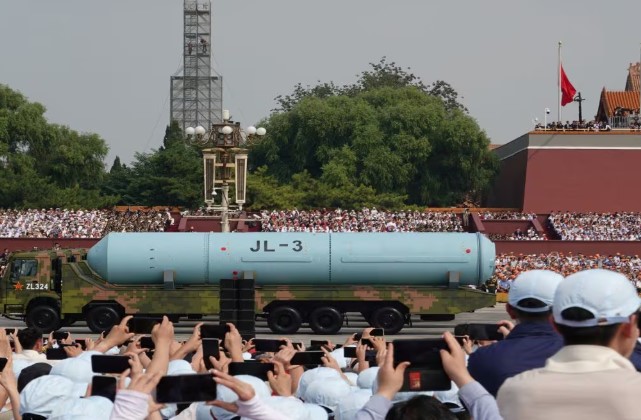China staged its largest military parade in a decade at Beijing’s Tiananmen Square, marking the 80th anniversary of the end of World War II. While the event was commemorative in name, the China military parade became a carefully choreographed exhibition of modern weaponry, with many systems revealed to the public for the first time.
Display of Nuclear and Long-Range Firepower at China Military Parade
At the heart of the China military parade was the country’s nuclear triad, which includes weapons launched from land, sea, and air. On land, the Dongfeng-5C intercontinental ballistic missile drew attention for its ability to carry up to ten nuclear warheads across more than 13,000 kilometres. Alongside it, the newly unveiled DF-61 missile appeared on a mobile launcher.
Its large size suggested it could carry heavier payloads and travel longer distances. The Julang-3 submarine-launched ballistic missile completed this strategic trio, allowing strikes from waters close to China’s shores.
In the skies, China rolled out a new long-range nuclear missile called the Jinglei-1. Analysts believe aircraft can launch this system, adding another dimension to China’s deterrent capabilities. Together, these weapons illustrated the strength of China’s modern strategic arsenal.
Beyond nuclear weapons, the focus shifted toward systems designed to threaten overseas bases and naval forces. The DF-26D, known as the “Guam Killer,” was one of the highlights. With a range of nearly 5,000 kilometres, it can target American facilities on Guam and carries both nuclear and conventional warheads. Its electronic warfare features, including jamming systems, make it more difficult to stop.
Accompanying it was the YJ-21, a hypersonic anti-ship missile that can be fired from destroyers or bombers. With a speed faster than Mach 5 and a range of over 600 kilometres, it was presented as a powerful weapon against aircraft carriers. Other anti-ship systems included the YJ-17, YJ-19, and YJ-20, all tailored to strike naval groups in the Indo-Pacific.
Hypersonic and Anti-Drone Arsenal at China Military Parade
One of the central themes of the China military parade was speed. Hypersonic weapons, which travel more than five times the speed of sound, played a prominent role. The DF-17 stood out as one of China’s signature hypersonic systems. It carries a glide vehicle that moves unpredictably, making it very difficult for opponents to intercept.
Several other missiles also feature hypersonic capabilities. Analysts highlighted the YJ-21 and YJ-17 for their ability to strike quickly and bypass traditional missile defences. Even the DF-26D, while not purely hypersonic, can perform high-speed manoeuvres during its final phase of flight. These weapons shorten response times for opponents and challenge existing defense networks.
Trump calls for Intel CEO Lip-Bu Tan to resign over alleged China military ties
Alongside speed, the parade displayed new defenses against aerial threats. China deployed what it called a triad of anti-drone systems. The LY-1 laser weapon fires concentrated beams of light to shoot down drones. Operators also displayed microwave weapons, which disable drone electronics with bursts of electromagnetic energy. To complete the triad, short-range missiles and automatic guns targeted drones of different sizes and speeds.
This range of directed-energy and traditional systems demonstrated a layered approach to countering the rising threat of drones on the battlefield.
Drones, Submarines, and Robot Wolves
Another key theme of the China military parade was autonomy — machines capable of operating with limited human control. The GJ-11 drone flew alongside crewed aircraft, acting as both a scout and a support system. It can carry ammunition, provide intelligence, or take on dangerous missions.
In the water, China presented the AJX002, an extra-large unmanned submarine measuring nearly 20 meters. This craft was described as suitable for tasks such as reconnaissance, laying underwater mines, or carrying heavy payloads over long distances. Its size indicated endurance and range that could make it useful in extended operations.
The ground segment was no less striking. Unmanned helicopters and stealthy surface ships were paraded, many designed with hidden antennas and radar-evading hulls. On land, robotic quadrupeds — nicknamed robot wolves — captured significant attention. These four-legged machines are capable of carrying supplies, scouting ahead, and even carrying weapons. Their ability to operate in dangerous zones without risking soldiers made them a symbolic highlight of the China military parade.
Chinese drone subs set to make first public appearance in Beijing parade
Traditional ground systems were also featured. The 99B main battle tank rolled through with advanced protection against missiles and drones. The PHL-16 multiple launch rocket system, with its modular design, was displayed as a flexible option for launching different rockets and tactical ballistic missiles. With ranges of up to 500 kilometres, this system underlined the importance of mobility and firepower in modern warfare.
The mix of nuclear missiles, hypersonic platforms, anti-drone technologies, drones, submarines, and robotic ground units revealed the depth of China’s modernisation drive. From sky to sea to land, the China military parade presented a broad spectrum of capabilities designed to showcase national power and technological advancement.

